Aeolian Islands
The Aeolian Islands (/iːˈoʊliən/ ee-OH-lee-ən; Italian: Isole Eolie [ˈiːzole eˈɔːlje]; Sicilian: Ìsuli Eoli; Greek: Αιολίδες Νήσοι, romanized: Aiolídes Nísoi), sometimes referred to as the Lipari Islands or Lipari group (/ˈlɪpəri/ LIP-ə-ree, Italian: [ˈliːpari]) after their largest island, are a volcanic archipelago in the Tyrrhenian Sea north of Sicily, named after the demigod of the winds Aeolus.[1] The islands' inhabitants are known as Aeolians (Italian: Eoliani). The islands have a permanent population of 14,224 at the 2011 Census; the latest official estimate (as at 1 January 2019) in 15,419. The Aeolian Islands are a popular tourist destination in the summer and attract up to 600,000 visitors annually.
| Native name: Isole Eolie, Ìsuli Eoli | |
|---|---|
 Aerial view of the Aeolian Islands | |
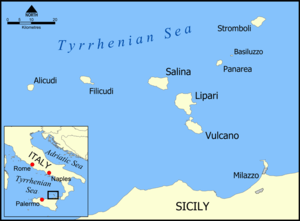 Map of the Aeolian Islands | |
| Geography | |
| Location | Tyrrhenian Sea |
| Coordinates | 38°32′N 14°54′E |
| Area | 114.7 km2 (44.3 sq mi) |
| Administration | |
Italy | |
| Region | Sicily |
| Province | Messina |
| Demographics | |
| Population | 15,419 (1 January 2019) |
| Pop. density | 134.4/km2 (348.1/sq mi) |
| Official name | Isole Eolie (Aeolian Islands) |
| Criteria | Natural: viii |
| Reference | 908 |
| Inscription | 2000 (24th session) |
| Area | 1,216 ha |
There are eight significant islands: Lipari, Vulcano, Salina, Stromboli, Filicudi, Alicudi, Panarea and Basilluzzo, and a set of minor islands and rocks between Panarea and Basilluzzo.
Geography
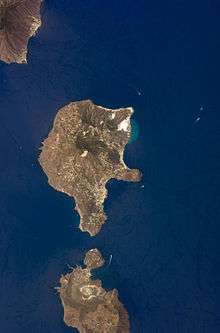
The present shape of the Aeolian Islands is the result of volcanic activity over a period of 260,000 years. There are two active volcanoes – Stromboli and Vulcano.[2] The volcanic activity of steaming fumaroles and thermal waters are on most of the islands. The volcanic activity has also left the islands with very fertile soil that is conducive to the growth of natural flora.[3]
Geologically the archipelago is defined as a volcanic arc.[4] The origin of the Aeolian Islands is due to movement of the Earth's crust as a result of plate tectonics. The African continental shelf is in constant movement towards Europe. Its subduction underneath the Eurasian plate generates magma, which rises to the surface to form the volcanoes. The "Aeolian Arc" extends for more than 140 km (87 mi), but the area of geological instability caused by the collision of Africa and Europe is much larger. It includes Sicily, Calabria, and Campania together with Greece and the Aegean islands.
The complex of the seven Aeolian Islands, covering an area of 1,600 km2 (620 sq mi), originated in the Tyrrhenian Basin, a great plain at the bottom of the Tyrrhenian Sea. Emissions of lava from depths of up to 3,600 m (11,800 ft) resulted in the formation of the Aeolian Islands, together with Ustica and a series of submarine volcanoes named Magnani, Vavilov, Marsili and Palinuro, as well as two that are unnamed.

Lipari. 
Panarea. 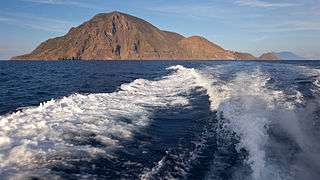 Filicudi.
Filicudi.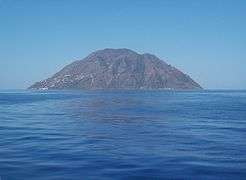 Alicudi.
Alicudi.
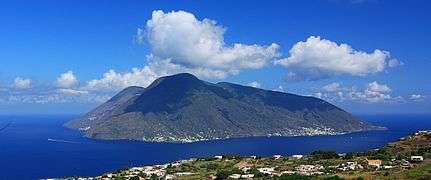
Salina. .jpg) Vulcano.
Vulcano.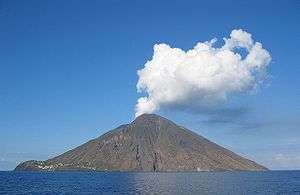
Stromboli.
Administration
The islands form part of the Sicilian province of Messina. All the islands except Salina comprise the commune of Lipari within that province; Salina forms three separate communes - Malfa, Leni and Santa Marina Salina.
Architectural control
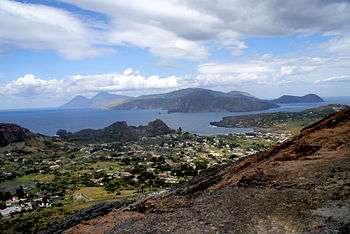
Curbing urban development has been a key to preserving the Aeolian islands in a natural state. New buildings are severely restricted. Existing residences can be bought and restored but must be constructed to resemble its whitewashed houses. Traditional houses consist of modular cubes[5] constructed from indigenous building materials—stone, lava, pumice and tufo. Almost all houses have a large outdoor terrace, usually shaded by grape-vines and flowering vines. The houses, balconies and terraces are mostly decorated with brightly patterned terra-cotta tiles, a throwback to long-ago Spanish conquerors.
History
4000–2500 BC
The first evidence of Sicilian migration was in Lipari (Castellaro Vecchio). A manufacture and commerce of obsidian objects was highly developed until the introduction of metals.
1600–1250 BC
During the Bronze Age, the Aeolians prospered by means of maritime commerce in an area which extended from Mycenae to the British Isles, from where tin was imported. Villages on the Aeolian islands flourished on Capo Graziano (Filicudi), Castello (Lipari), Serro dei Cianfi (Salina), Capo Milazzese (Panarea), and Portella (Salina). All these settlements were destroyed by new Italic invasions in 1250 BC.
1240–850 BC
The Aeolian Islands were occupied by the Ausonians led by Liparus. Liparus was succeeded by Aeolus whose house, according to the Odyssey by Homer, gave hospitality to Odysseus.
600–300 BC
In 580 BC, Greeks exiled from Rhodes and Knidos landed at Lipari and began a period of Greek domination, which was known for acts of piracy against Etruscan and Phoenician shipping. There was production of vases and other ceramics.
300 BC–AD 250
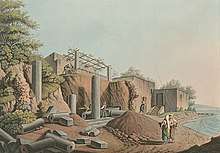
The islanders were allies of the Carthaginians against Rome during the Punic Wars. Although the Battle of the Lipari Islands in 260 BC led to a Carthaginian victory, the Romans later sacked Lipari and their domination led to a period of poverty.
AD 250–1000
At the fall of the Roman Empire, the Aeolian Islands came under the sway of the Visigoths, the Vandals and the Ostrogoths, followed by the domination of the Byzantine Empire. In 264, a coffin which contained the body of Bartholomew washed up on the beach of Lipari, with the result that Bartholomew was immediately elected the patron saint of the Aeolian Islands. Calogeras the hermit was active on Lipari during the first half of the 4th century and he gave his name to the thermal springs. In 836 the Arabs sacked Lipari, massacred most of the population, and enslaved the survivors.
1000–1500
The Normans conquered Sicily from the Arabs in 1061. Roger II of Sicily sent the Benedictine monks to Lipari, which gave rise to considerable development on the islands. A cathedral dedicated to Saint Bartholomew was built, as well as the Benedictine monastery in the castle. Lipari became a Roman Catholic Diocese of Lipari and agriculture made progress in Salina, as well as the smaller islands. In 1208 Frederick II of Swabia acceded to the throne of Sicily. The period of prosperity which followed, and which was consolidated during the course of his reign, ended with the domination of the Angevins and the rebellion of the Sicilians which culminated in the revolt of the Sicilian Vespers. The Aeolians however, remained loyal to Charles of Anjou, and commercial links were established with Naples, the capital of the Angevin kingdom. In 1337 Lipari opened its gates to the French fleet without resistance, and in return obtained various commercial and fiscal benefits. In the mid-15th century, Naples and Palermo united into the Kingdom of the Two Sicilies under the crown of Alfonso V of Aragon. Aeolian privileges were recognized. Aeolian privateers fought alongside the Spanish against the French.
1500–present

On June 30, 1544, a fleet of 180 Ottoman vessels under the command of the corsair Hayreddin Barbarossa occupied Lipari and laid siege to the castle. The defenders surrendered. Historically, it is said around 9,000 of the 10,000 citizens of Lipari were captured and enslaved although a couple of more recent scholars have questioned this number arguing for a lower population at the time of Barbarossa.[6] A number of citizens were ransomed in Messina and returned to the islands but most of those captured never returned. Only after the tragedy did the Spanish authorities turn their attention to Lipari and repopulate the city with Sicilian, Calabrian and Spanish families. The city walls and houses were rebuilt and an Aeolian fleet was constructed which was able to successfully defend the Tyrrhenian Sea from the Ottomans.
In 1693, an earthquake destroyed all the towns in eastern Sicily, causing around 60,000 deaths.[7] After the population invoked the protection of Saint Bartholomew during prayers in the cathedral, there was not a single victim on the Aeolian Islands. The economic conditions of the islands improved greatly during the 17th century with agricultural progress (malvasia grapes, capers, and a variety of fruit, vegetables and fishing). With the Bourbons came the introduction of criminal and political prisoners to the islands. In 1916, the penal colony was closed, but the Fascist regime unsuccessfully tried to reopen it in 1926. The island population reacted by pulling down the remains of the ex-penitentiary in the castle. However, not long after, the castle was converted to accommodate anti-Fascist political prisoners in enforced exile. Liparians fraternized with these exiles until the Allies' liberation. After the war, the same room that had housed the opponents of Fascism became the Aeolian Archaeological Museum.
Towards the end of the 19th century, the Aeolian Islands were visited by Archduke Ludwig Salvator of Austria—a friend of the islands and also a man with a profound knowledge of the archipelago. Between the years 1893–96 he published a work of eight volumes on the Aeolian Islands.
In August 1888, the crater named Fossa on Vulcano erupted and caused many deaths in the sulphur mines. The eruptions continued for 19 months.[8]
On New Year's Day in 1909, a rumor appeared in international newspapers that the Aeolian Islands had been "swallowed up by the sea" during a time of volcanic activity.[9] While communication with the islands was interrupted for a time,[10] they were not otherwise lost.
During World War II, all of the Aeolian Islands were captured by the Allies in August 1943, during the invasion of Sicily.[11]
UNESCO World Heritage Sites
The Aeolian Islands were listed by UNESCO in 2000 as a World Heritage Site for providing "an outstanding record of volcanic island-building and destruction, and ongoing volcanic phenomena".[12] Status as a World Heritage Site was threatened by Italy's failure to close the pumice quarry as well as its failure to prevent the building of 4 new harbors.[13] However, as of January 2019, it is still listed by UNESCO as a World Heritage site.[14]
See also
References
- Mike Dixon-Kennedy (1998). Encyclopedia of Greco-Roman mythology. p. 15. ISBN 1-57607-094-8.
- "The Aeolians: The Volcanic Islands". Retrieved 2013-08-03.
- Gasson, John (19 October 2016). "Falling in Love With Italy's Blissful, Rustic Aeolian Islands". The New York Times. Retrieved 4 January 2017.
- The Aeolian archipelago
- Belford, R.; Dunford, M.; Woolfrey, C. (2003). Italy. Italy (Rough Guides). Rough Guides. p. 1162. ISBN 978-1-84353-060-2.
- Joe Russo (October 1, 2015). "Estimating the population of Lipari in 1544". Aeolian Genealogy. Retrieved 18 November 2017.
- Rodríguez de la Torre, Fernando (1995). "Spanish sources concerning the 1693 earthquake in Sicily" (PDF). Annali di Geofisica. 38 (5–6): 526., Juan Francisco Pacheco y Téllez-Girón, 4th Consort Duke of Uceda the Spanish Viceroy of Sicily at the time reported "...and about sixty thousand people died under the ruins of the earthquake" (August 4, 1695)
- Eolian Archaeological Museum. Lipari, Isole Eolie
- "Aeolian Islands Not Sunk" Atchison Daily Champion (1 January 1909): 1. via Newspapers.com

- "Aeolian Islands Isolated" Dakota Huronite (14 January 1909): 7. via Newspapers.com

- "Foggia Blasted; Aeolian Isles Seized" Kingsport News (21 August 1943): 1. via Newspapers.com

- "World Heritage Committee Inscribes 61 New Sites on World Heritage List". UNESCO World Heritage Centre. Retrieved 7 January 2017.
- Eddyburg.it – Le Eolie fuori dai siti Unesco Archived September 27, 2007, at the Wayback Machine
- Isole Eolie (Aeolian Islands): Indicators. UNESCO.
Further reading
- Ward, Phillip (1974). The Aeolian Islands. The Oleander Press. ISBN 0902675435
- Berlinghieri, Castagnino E.F. (with introduction by A. J. Parker) (2003) The Aeolian Islands: crossroads of Mediterranean maritime routes. A survey on their maritime archaeology and topography from the Prehistoric to the Roman periods, British Archaeological Reports, International Series 1181, Oxford.
External links

- UNESCO World Heritage Sites, Aeolian Islands


